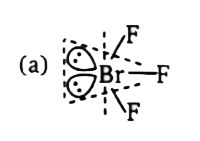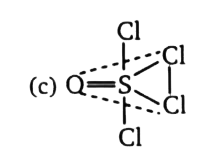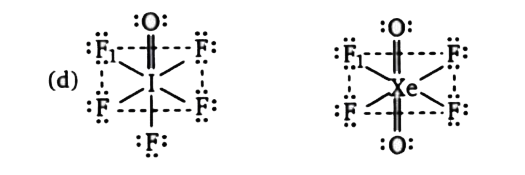The comcept of redistribution of energy in different orbitals of an atom associated with different energies to give new orbitals of equal (or somethimes it may be non-equal) energy oriented in space in definite directions is called hybridization and formed new orbitals are called hybrid orbitals. The bonds formed by such orbitals are called hybrid bonds. The process of mixing of orbitals itself requires some energy. Thus, some additional energy, is needed for the hybridisation (mixing) of atomic orbitals.
Q. Which of the following statement is correct?
In , maximum three halogen atoms can lie in same plane
In molecule all hydrogen atoms which bonded to overlapping, lie in equitorial plane
In equitorial bond angle is greater than
Molecules have similar shape but have different number of lone pairs in whole molecule
The correct Answer is:B
(a)  Maximum number of atoms that can lie in a plane =4
Maximum number of atoms that can lie in a plane =4
(b) Hydrogen atoms bonded by overlapping lie in axial
Hydrogen atoms bonded by overlapping lie in axial
(c) is less than due to shifting of s-character in S=O bond. (d)
is less than due to shifting of s-character in S=O bond. (d) 
No. of lone pairs =17 : No.of lone pairs=16
Topper's Solved these Questions
- CHEMICAL BONDING (ADVANCED)Book:VK JAISWALChapter:CHEMICAL BONDING (ADVANCED)Exercise:ONE OR MORE ANSWER IS/ARE CORRECT
Explore 84 Videos
- CHEMICAL BONDING (ADVANCED)Book:VK JAISWALChapter:CHEMICAL BONDING (ADVANCED)Exercise:MATCH THE COLUMN
Explore 26 Videos
- CHEMICAL BONDING (ADVANCED)Book:VK JAISWALChapter:CHEMICAL BONDING (ADVANCED)Exercise:Level 2
Explore 156 Videos
- CHEMICAL BONDING (BASIC)Book:VK JAISWALChapter:CHEMICAL BONDING (BASIC)Exercise:Level 3 (Passive 11)
Explore 6 Videos
Similar Questions
Due to hybridisation________hybrid orbitals are formed .
View SolutionThe comcept of redistribution of energy in different orbitals of an atom associated with different energies to give new orbitals of equal (or somethimes it may be non-equal) energy oriented in space in definite directions is called hybridization and formed new orbitals are called hybrid orbitals. The bonds formed by such orbitals are called hybrid bonds. The process of mixing of orbitals itself requires some energy. Thus, some additional energy, is needed for the hybridisation (mixing) of atomic orbitals.
Q. In neutral moleule XeOn1Fn2, central atom has no lone pair and ratio of n2n1 is two, then which of the following orbitals does not participate in bonding (n1andn2 are natural numbers):
View Solution
Knowledge Check
The comcept of redistribution of energy in different orbitals of an atom associated with different energies to give new orbitals of equal (or somethimes it may be non-equal) energy oriented in space in definite directions is called hybridization and formed new orbitals are called hybrid orbitals. The bonds formed by such orbitals are called hybrid bonds. The process of mixing of orbitals itself requires some energy. Thus, some additional energy, is needed for the hybridisation (mixing) of atomic orbitals.
Q. Select from each set the molecule or ion having the smallest bond angle :
(i) H2Se,H2TeandPH3
(ii) NO−2andNH−2
(iii) POF3andPOCl3 (X−P−X angle)
(iv) OSF2Cl2andSF2(CH3)2 (F−S−F angle)AH2Se,NH−2POF3andOSF2Cl2BH2Te,NO−2,POF3andSF2(CH3)2CPH3,NH−2,POCl3andSF2(CH3)2DH2Te,NH−2,POF3andSF2(CH3)2The comcept of redistribution of energy in different orbitals of an atom associated with different energies to give new orbitals of equal (or somethimes it may be non-equal) energy oriented in space in definite directions is called hybridization and formed new orbitals are called hybrid orbitals. The bonds formed by such orbitals are called hybrid bonds. The process of mixing of orbitals itself requires some energy. Thus, some additional energy, is needed for the hybridisation (mixing) of atomic orbitals.
Q. Select from each set the molecule or ion having the smallest bond angle :
(i) H2Se,H2TeandPH3
(ii) NO−2andNH−2
(iii) POF3andPOCl3 (X−P−X angle)
(iv) OSF2Cl2andSF2(CH3)2 (F−S−F angle)AH2Se,NH−2POF3andOSF2Cl2BH2Te,NO−2,POF3andSF2(CH3)2CPH3,NH−2,POCl3andSF2(CH3)2DH2Te,NH−2,POF3andSF2(CH3)2The comcept of redistribution of energy in different orbitals of an atom associated with different energies to give new orbitals of equal (or somethimes it may be non-equal) energy oriented in space in definite directions is called hybridization and formed new orbitals are called hybrid orbitals. The bonds formed by such orbitals are called hybrid bonds. The process of mixing of orbitals itself requires some energy. Thus, some additional energy, is needed for the hybridisation (mixing) of atomic orbitals.
Q. In neutral moleule XeOn1Fn2, central atom has no lone pair and ratio of n2n1 is two, then which of the following orbitals does not participate in bonding (n1andn2 are natural numbers):Adx2BpxCdx2−y2DNone of these
Sp-hybrid orbital is formed by
View SolutionThe bond angle formed by different hybrid orbitals are in the order
View SolutionAs compared to pure atomic orbitals, hybrid orbitals have
View SolutionA hybrid orbital formed from s and p-orbital can contribute to
View SolutionThe bond angle formed by different hybrid orbitals are in the order
View Solution
